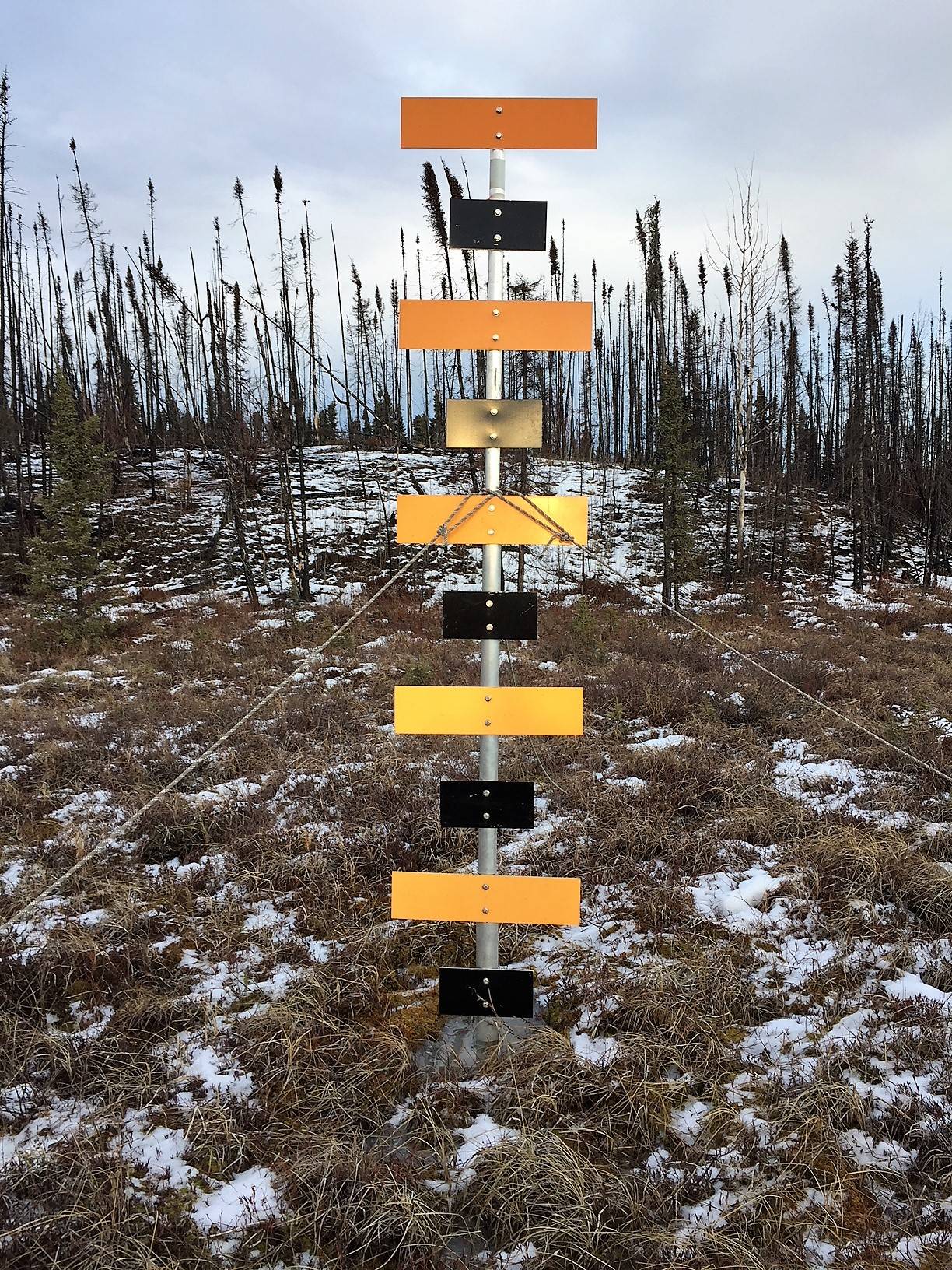The longer days and sun warming my office have me thinking somewhat disappointingly about trading out my skis for my bike. I am one of the many people on the Kenai Peninsula who loves snow. When the snow is good, we can ski, snowshoe, snowmachine, and mush dogs on the Kenai National Wildlife Refuge. Each year’s snowfall pattern is different, so refuge staff monitor snow depths from December to April.
Federally-coordinated snow monitoring began in the 1930s because Congress needed information about mountain snowpack to forecast water supply for the western U.S. The SNOTEL (SNOwpack TELemetry) program was born and federal workers began to standardize and validate data collection. The first surveys, called Snow Courses, require a person to visit each site to measure snow depth and weigh the snow to estimate how much water is being held. Aerial markers were also used as a quicker method to gauge snow depth from a plane (see photo). The Natural Resources Conservation Service (NRCS), an agency within the U.S. Department of Agriculture, currently coordinates the SNOTEL program (https://www.wcc.nrcs.usda.gov/snow/). Manual surveys are conducted during a 5-day window at the beginning of each month because snow levels can change quickly. Storms can dump snow over a couple days or a warm spell can cause significant melt.
In the 1980s, automated SNOTEL stations were added to the network. These stations have sensors to collect more information such as precipitation, soil temperature, and soil moisture. Measurements, taken several times a day, are remotely-transmitted to a central database. NRCS staff crunch the data into products and reports to help us understand snowpack and water availability.
Currently there are 15 SNOTEL stations in Alaska that collect snow and soil information including five on the Kenai Peninsula. One is located in the Kenai Moose Research Center at the end of Swan Lake Road. This April, the amount of water available as snow is 74 percent of normal levels, while precipitation accumulation is 111 percent of normal. In other words, this SNOTEL station had more water available as rain than snow this winter when compared to the last 30 years.
The Kenai Refuge is almost two million acres, of which a large portion is accessible only by aircraft, so we use aerial markers to measure how much snow is on the ground. Our refuge pilot recently flew over 17 markers and recorded how many panels were covered with snow. Caribou Hills had nearly 5 feet of snow in December and currently has over 6 feet. In contrast, the Kenai Lowlands had patchy snow in December, but had a foot of snow by February.
Another 25 locations are monitored by other agencies for snow depth elsewhere on the Kenai Peninsula. Collectively, these 42 sites are among the more than 200 locations in Alaska where snow depth information is collected as part of the NRCS program.
Snow insulates the ground during the very cold months. Subnivean habitats, which occur under the snow, remain around 32 degrees even when outside temperatures become bitterly cold. S mall mammals find shelter and food here, which increases their chances of surviving the winter. Snow insulation is also important for plants. Freeze events when snow is not present can damage plant tissue and this can stunt growth over the next year. For example, a study in Scandinavia linked a loss of snow followed by freezing temperatures to a loss of nearly 90 percent of summer growth for a crowberry species. The plant damage was so extensive it was visible in satellite imagery.
The impetus for the SNOTEL program was to understand water availability. When and how much water is available is also important to ecosystems here on the Kenai. Snow acts as a storage bank for water. Snow melt releases water slowly and can be a reliable source for plants and animals throughout the spring into the summer. For example, snowpack is a major source of water for both glacial and non-glacial salmon rivers. However, when winter precipitation occurs as rain, most of the water flows over frozen earth and ends up in the ocean.
We might not all love snow, but I think we probably all can find something we love that relies on snow.
Dr. Magness is a landscape ecologist at Kenai National Wildlife Refuge. Find more information at http://kenai.fws.gov or http://www.facebook.com/kenainationalwildliferefuge.

